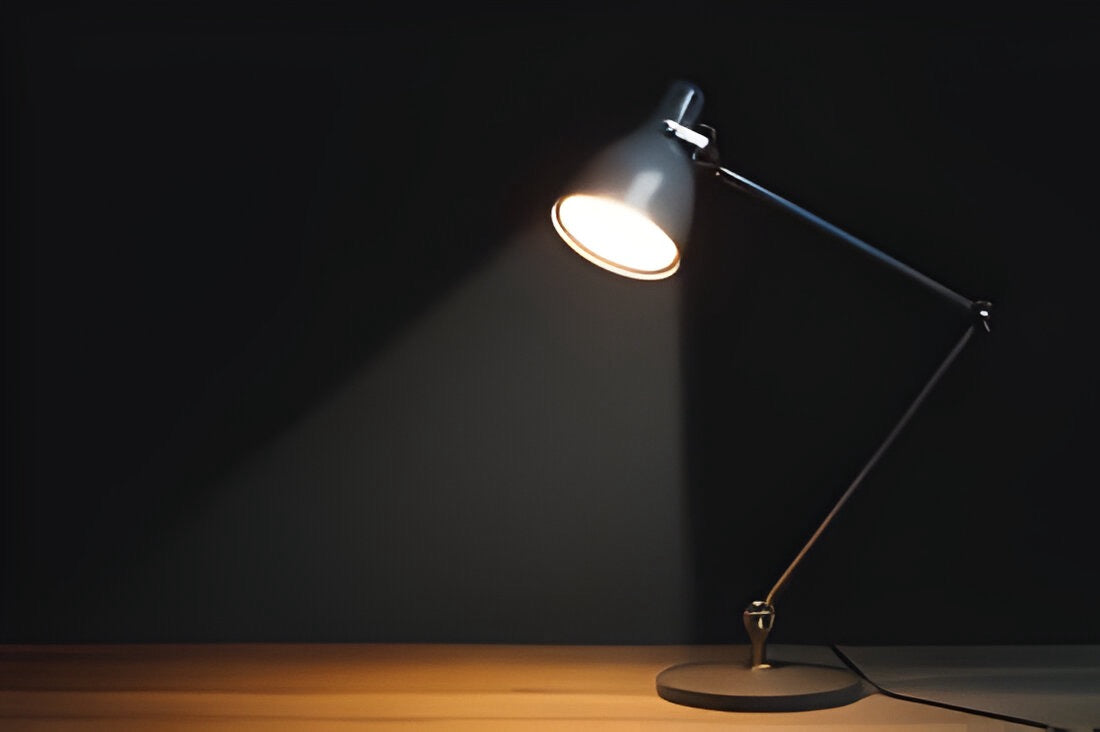


The right lighting in the workplace is crucial for creating a productive and pleasant working environment. It not only has a significant impact on your concentration and performance, but also on your health and well-being. In times of working from home and flexible workplaces, the importance of optimal lighting has become even greater, as the lighting conditions in a private study are not always ideal. In this article, you will learn how to create the ideal workplace lighting with the right lighting design - both in the office and in the home office.
Good lighting in the workplace is not just a question of aesthetics, but above all of health. Inadequate or incorrect lighting can lead to a number of complaints, including:
The right lighting has a direct impact on your productivity. Bright, even light helps to increase alertness and concentration. Studies have shown that employees who work in well-lit offices are more productive and make fewer mistakes than those who work in poor lighting conditions.
Light also affects your mood. Natural daylight promotes the release of serotonin, which is considered the "happiness hormone". Artificial light, especially in cool white tones, can also have a mood-enhancing effect and help you stay energized and alert throughout the day. Pleasant lighting helps you feel better and more motivated.
There are different types of lighting that should work together to create an optimally lit workplace. Each type of lighting has its own purpose and specific areas of application.
The general lighting is the basic lighting of a room. It ensures that the room is evenly lit and serves as the starting point for the entire lighting design. Most offices use ceiling lights or pendant lights to illuminate the entire room. It is important that the general lighting is neither too bright nor too dark in order to avoid glare or shadows. A variety of suitable ceiling lights and panels can be found here.
The zone lighting focuses on specific work areas and ensures that you have sufficient light exactly where you need it. This is particularly important for activities that require precise work, such as working at a desk. Desk lamps or specifically placed wall lights are an ideal choice here. Accent lighting can also be used to highlight certain areas such as bookshelves or works of art, adding depth to the room. A selection of desk lamps and wall lights you can find here.
Natural daylight is the best light source for the workplace. It not only improves mood, but also helps to regulate the body's internal clock. A window seat is therefore ideal. However, if you don't have enough daylight available, the use of artificial light is unavoidable. In this case LED lamps are the best choice. Not only are they energy-efficient and long-lasting, but they can also be selected in different color temperatures to mimic the effect of daylight.
To create a pleasant and productive working environment, it is important to choose the right lamps and place them in the right places. Here are the most important criteria you should consider:
Light intensity, measured in lux, is crucial for the quality of workplace lighting. Too little lighting strains the eyes and makes it difficult to see details, while too much light can be dazzling. A light intensity of around 500 lux is recommended for VDU work. Up to 1,000 lux may be necessary for fine work, such as reading documents or manual tasks.
If you are looking for suitable lamps that meet these requirements, you can take a look at the desk lamps on buynblue.com at buynblue.com.
The color temperature, measured in Kelvin, determines the light color. Warm white light (approx. 2,700-3,000 K) creates a cozy atmosphere and is well suited for living rooms or relaxed working environments. For concentrated work, however, neutral white (approx. 3,500-4,500 K) or cool white light (from 5,000 K) is recommended, as it increases alertness and concentration. In offices and workspaces, the color temperature should therefore be in the range of 4,000 to 5,000 K.
Glare is not only unpleasant, it can also put a lot of strain on your eyes. Make sure that your light sources are positioned in such a way that they do not create direct reflections on your screen. Lights with diffusers that spread the light evenly can also help to reduce glare. Here are glare-free desk lamps are an advantage, which you can find here can find here.
The right combination and placement of light sources is crucial for optimum lighting at the workplace. Here are some practical tips:
Make sure that you position your lamps so that they do not cast shadows on your work area. For example, if you are right-handed, the light source should come from the Left so that your hand does not cast a shadow on the work surface. Wall lights or pendant lights mounted above your work area are particularly suitable for providing wide-area lighting.
Adjustable desk lamps that you can direct in different directions as required are ideal for responding flexibly to different work requirements. Dimmable lights that allow you to individually adjust the light intensity also offer additional convenience. A selection of flexible and dimmable desk lamps you can find here.
Try to integrate as much daylight as possible into your workspace. Ideally, place your desk near a window. If direct sunlight causes glare, you can remedy this with blinds or curtains without having to give up daylight.
Sustainability also plays an important role when it comes to workplace lighting. Here are some ways in which you can save energy and protect the environment at the same time:
LED lamps are the most energy-efficient lighting option. They consume up to 80 % less electricity than conventional light bulbs and have a service life of up to 25,000 hours. This makes them not only an environmentally friendly solution, but also a cost-saving one. Many of the lights on buynblue.com use energy-efficient LED technology.
By using timers or motion detectors, you can ensure that the lighting is only switched on when it is actually needed. Smart home solutions offer additional options for controlling and switching the lighting on and off via an app.
Make sure that you don't use more light than necessary. It is often sufficient to illuminate just the work area instead of the entire room. Energy-saving light bulbs and dimmable lights help to reduce electricity consumption.
Lighting requirements differ depending on the working environment. In the office, standardized lighting concepts are usually available, while in the home office you have more flexibility to adapt the lighting to your personal needs.
In the home office, you often have less space and possibly less daylight available. Here it can make sense to opt for compact but powerful desk lamps that are both functional and decorative. Make sure that you can flexibly adapt the light source to your work requirements.
In offices, the aim is often to illuminate the entire room evenly in order to offer all employees optimum working conditions. At home, on the other hand, you can implement more individual lighting concepts that are tailored to your personal working style. Take advantage of the opportunity to combine light sources and create different moods.
In addition to the right lighting, the ergonomic design of your workplace also plays a key role in productivity and well-being. Optimal lighting alone is not enough if your workspace is not adapted to your posture and working style. This is where cooperation between lighting and ergonomics is crucial:
To find the perfect balance between lighting and ergonomics, it is important to place light sources in such a way that they do not cast annoying shadows on your work surface. A desk lamp with an adjustable arm helps you to direct the light precisely while preventing unpleasant reflections on the screen. This is not only easy on your eyes, but also on your neck, as you don't have to bend forward unnecessarily to see details.
Adjustable and dimmable lights offer the flexibility you need for different tasks. Bright lighting can help with work that requires a lot of concentration, while a dimmed atmosphere is beneficial for creative processes. In addition, smart lighting systems that can be controlled via apps allow you to adjust the light intensity to changing times of day and requirements. High-quality, ergonomic desk lamps can be found at buynblue.com.
The right workplace lighting is crucial for your health, productivity and well-being. By carefully selecting light sources, positioning them correctly and considering factors such as light intensity and color temperature, you can create an optimal working environment. If you are looking for high-quality and energy-efficient luminaires, take a look at the wide selection of office and workplace lighting at buynblue.com .
The light intensity at the workplace is measured in lux. An illuminance of around 500 lux is recommended for VDU work. For detailed activities, such as reading or manual work, lighting of up to 1,000 lux can be useful. It is important that the lighting is neither too dark nor too bright in order to avoid eye strain and glare.
Neutral white to cool white light with a color temperature of 4,000 to 5,000 Kelvin is suitable for productive work. This light color promotes concentration and alertness. Warm white light (2,700-3,000 K) is more suitable for relaxing activities or homely environments.
To avoid glare, you should position your light sources so that they do not shine directly onto your screen or into your eyes. Use lights with diffusers that spread the light evenly. Adjustable desk lamps are also helpful as you can adjust them as needed. You can find a selection of glare-free desk lamps at buynblue.com.
Yes, LED lamps are highly recommended for the workplace. They are energy efficient, have a long life and offer a wide range of color temperatures. LED lamps also generate less heat and do not flicker, making them ideal for long working hours.